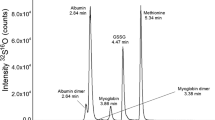Abstract
Herein, we describe the development of a fluorescence-based high throughput assay to determine the small molecule binding towards human serum albumin (HSA). This innovative competition assay is based on the use of a novel fluorescent small molecule Red Mega 500 with unique spectroscopic and binding properties. The commercially available probe displays a large fluorescence intensity difference between the protein-bound and protein-unbound state. The competition of small molecules for HSA binding in the presence of probe resulted in low fluorescence intensities. The assay was evaluated with the library of pharmacological active compounds (LOPAC) small molecule library of 1,280 compounds identifying known high protein binders. The small molecule competition of HSA−Red Mega 500 binding was saturable at higher compound concentrations and exhibited IC50 values between 3 and 24 μM. The compound affinity toward HSA was confirmed by isothermal titration calorimetry indicating that the new protein binding assay is a valid high throughput assay to determine plasma protein binding.

A high throughput fluorescence-based serum protein binding assay









Similar content being viewed by others
References
He XM, Carter DC (1992) Atomic structure and chemistry of human serum albumin. Nature 358:209–215
Vuignier K, Schappler J, Veuthey JL, Carrupt PA, Martel S (2010) Drug-protein binding: a critical review of analytical tools. Anal Bioanal Chem 398(1):53–66
Lázaro E, Lowe PJ, Briand X, Faller B (2008) New approach to measure protein binding based on a parallel artificial membrane assay and human serum albumin. J Med Chem 51(7):2009–2017
Ballard P, Rowland M (2011) Correction for nonspecific binding to various components of ultrafiltration apparatus and impact on estimating in vivo rat clearance for a congeneric series of 5-ethyl, 5-n-alkyl barbituric acids. Drug Metab Dispos 39(12):2165–2168
Valko K, Nunhuck S, Bevan C, Abraham MH, Reynolds DP (2003) Fast gradient HPLC method to determine compounds binding to human serum albumin. Relationships with octanol/water and immobilized artificial membrane lipophilicity. J Pharm Sci 92:2236–2248
El-Hady D, Kühne S, El-Maali N, Wätzig H (2010) Precision in affinity capillary electrophoresis for drug-protein binding studies. J Pharm Biomed Anal 55(2):232–241
Huber W, Mueller F (2006) Biomolecular interaction analysis in drug discovery using surface plasmon resonance technology. Curr Pharm Des 12(31):3999–4021
Brandts JF, Lin LN (1990) Study of strong to ultratight protein interactions using differential scanning calorimetry. Biochemistry 29(29):6927–6940
Patton WF (2000) A thousand points of light: the application of fluorescence detection technologies to two-dimensional gel electrophoresis and proteomics. Electrophoresis 21(6):1123–1144
Stryer L (1965) The interaction of a naphthalene dye with apomyoglobin and apohemoglobin. A fluorescent probe of nonpolar binding sites. J Mol Biol 13(2):482–495
Moreno F, Cortijo M, Gonzalez-Jimenez J (1999) The fluorescent probe prodan characterizes the warfarin binding site on human serum albumin. Photochem Photobiol 69(1):8–15
Mathias U, Jung M (2007) Determination of drug–serum protein interactions via fluorescence polarization measurements. Anal Bioanal Chem 388:1147–1156
Yasgar A, Furdas SD, Maloney DJ, Jadhav A, Jung M, Simeonov A (2012) High-throughput 1,536-well fluorescence polarization assays for a1-acid glycoprotein and human serum albumin binding. PLoS ONE 7(9):1–12
Seidler J, McGovern SL, Doman TN, Shoichet BK (2003) Identification and prediction of promiscuous aggregating inhibitors among known drugs. J Med Chem 46(21):4477–4486
Zhang J-H, Chung TDY, Oldenburg KR (1999) A simple statistical parameter for use in evaluation and validation of high throughput screening assays. J Biomol Screen 4(2):67–73
Wenzel M, Czerney P, Schweder B, Lehmann F (2006) Protein Identifying and Quantifying Method. WO 2006/079334A2
Sarkar N, Das K, Nath DN, Bhattacharyya K (1994) Twisted charge transfer process of Nile Red in homogeneous solution and in faujasite seolite. Langmuir 10(326–329):326
Dayer P, Leemann T, Marmy A, Rosenthaler J (1985) Interindividual variation of beta-adrenoceptor blocking drugs, plasma concentration and effect: influence of genetic status on behaviour of atenolol, bopindolol and metoprolol. Eur J Clin Pharmacol 28(2):149–153
Patel L, Johnson A, Turner P (1984) Nadolol binding to human serum proteins. J Pharm Pharmacol 36(6):414–415
Wan H, Rehngren M (2006) High-throughput screening of protein binding by equilibrium dialysis combined with liquid chromatography and mass spectrometry. J Chromatogr A 1102(1–2):125–134
Gladziwa U, Klotz U (1993) Pharmacokinetics and pharmacodynamics of H2-receptor antagonists in patients with renal insufficiency. Clin Pharmacokinet 24(4):319–332
MacGowan AP (2003) Pharmacokinetic and pharmacodynamic profile of linezolid in healthy volunteers and patients with gram-positive infections. J Antimicrob Chemother 51(S2):ii17–ii25
Zlotos G, Bucker A, Kinzig-Schippers M, Sorgel F, Holzgrabe U (1998) Plasma protein binding of gyrase inhibitors. J Pharm Sci 87(2):215–220
Anderson B, Peyster Ad, Gad S, Hakkinen PJ, Kamrin M, Locey B, Mehendale H, Pope C, Shugart L (eds) (2005) Encyclopedia of Toxicology. 2nd edn. Elsevier Inc
Andersson T, Weidolf L (2008) Stereoselective disposition of proton pump inhibitors. Clin Drug Investig 28(5):263–279
Bree F, Urien S, Nguyen P, Riant P, Albengres E, Tillement JP (1990) A re-evaluation of the HSA-piroxicam interaction. Eur J Drug Metab Pharmacokinet 15(4):303–307
Levitzki A, Mishani E (2006) Tyrphostins and other tyrosine kinase inhibitors. Annu Rev Biochem 75:93–109
Ghuman J, Zunszain PA, Petitpas I, Bhattacharya AA, Otagiri M, Curry S (2005) Structural basis of the drug-binding specificity of human serum albumin. J Mol Biol 353(1):38–52
Zsila F (2013) Subdomain IB is the third major drug binding region of human serum albumin: toward the three-sites model. Mol Pharm 10(5):1668–1682
Acknowledgments
The work was supported by the University of Wisconsin–Milwaukee, the University of Wisconsin-Milwaukee Research Growth Initiative (RGI), National Institute of Drug Abuse DA031090, the University of Wisconsin-Milwaukee Research Foundation, the Lynde and Harry Bradley Foundation, and the Richard and Ethel Herzfeld Foundation. Further support was enabled by the Molecular Libraries Initiative of the National Institutes of Health Roadmap for Medical Research and the Intramural Research Program of the NHGRI, NIH. We also thank Dr. Frick to enable the use of the ITC instrument.
Author information
Authors and Affiliations
Corresponding author
Rights and permissions
About this article
Cite this article
McCallum, M.M., Pawlak, A.J., Shadrick, W.R. et al. A fluorescence-based high throughput assay for the determination of small molecule−human serum albumin protein binding. Anal Bioanal Chem 406, 1867–1875 (2014). https://doi.org/10.1007/s00216-013-7560-3
Received:
Revised:
Accepted:
Published:
Issue Date:
DOI: https://doi.org/10.1007/s00216-013-7560-3




